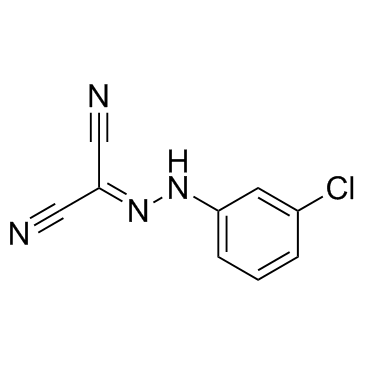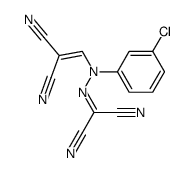| Description |
CCCP is an oxidative phosphorylation uncoupler.
|
| Related Catalog |
|
| Target |
STING[1] IFN-β[1]
|
| In Vitro |
CCCP inhibits IFN-β production induced by various types of the STING pathway activators. CCCP suppresses the phosphorylation of STING, TBK1, and IRF3 via disrupting the association of STING and TBK1. CCCP inhibits activation of STING and its downstream signaling molecules, TBK1 and IRF3, but not STING translocation to the perinuclear region. CCCP impairs the interaction between STING and TBK1 and concomitantly triggers mitochondria fission. Importantly, the knockout of the crucial mitochondria fission regulator Drp1 restored the STING activity, indicating that CCCP down-modulates the STING pathway through DRP1-mediated mitochondria fragmentation. The protonophore CCCP that disrupts membrane potential suppresses the DMXAA-triggered STING signaling pathway. CCCP drastically suppresses the production of IFN-β in DMXAA-treated RAW264.7 cells and MEFs[1].
|
| In Vivo |
The same dosage of 3 mg/kg.bw each of CCCP and PPEF is used. In both the cases 1 log reduction is observed in the bacterial load. However, when 3 mg/kg.bw of PPEF is used in combination with 3 mg/kg.bw of CCCP, 6 log10 reduction is observed in the bacterial count. The developed model validates the enhanced antibacterial activity of combination therapy[2].99mTc-MIBI signals in the hearts of SD rats administered CCCP (4 mg/kg intraperitoneally) or vehicle is also measured. 99mTc-MIBI signals decrease in rat hearts administered CCCP, and the ATP content, as measured by 31P magnetic resonance spectroscopy, decreased simultaneously. To investigate whether CCCP decreased the 99mTc-MIBI signals in rats, we analyzed the radioisotope activity of excised heart tissue from rats administered CCCP. At 180 min after 99mTc-MIBI injection, the 99mTc-MIBI signals from the hearts in the CCCP group are significantly lower than those in the vehicle group[3].
|
| Cell Assay |
MEFs (5×105), Raw264.7 cells (1×106), and HeLa cells stable expressing STING (1.5×105) are stimulated with DMXAA (100 μg/mL) for 2 or 3 h, or transfected with c-di-GMP (5 μM), cGAMP (5 μg/mL), or poly (dA:dT) (2 μg/mL) for 6 h. CCCP (50 μM) is co-treated with DMXAA (100 μg/mL), or treated for the last 5 h in case of treatment of c-di-GMP or poly (dA:dT)[1].
|
| Animal Admin |
Mice[2] Female Balb/c mice n=6, per dosing group weighing 20-25 g are rendered neutropenic with 2 intraperitoneal injections of cyclophosphamide 150 mg/kg.bw and 100 mg/kg.bw on 4 days and 1 day prior to bacterial infection. 0.1 mL of the 106 CFU/mL bacterial suspension is injected into right posterior thigh muscle. After 2 h post-infection mice are treated with PPEF (3 mg/kg.bw), CCCP (3 mg/kg.bw) and in combination PPEF+CCCP (3 mg/kg.bw+3 mg/kg.bw) dissolved in 0.1 mL sterile water by single bolus intravenous injection. Twenty-four hours after antibacterial administration, the mice are humanely sacrificed. Right thigh muscles from each mouse are aseptically collected, homogenized and serially diluted and processed for quantitative cultures. Rats[3] Rats are randomly divided into three groups. One group is euthanized 15 min after a dose of 12.5 MBq (337.8 μCi) 99mTc-MIBI injection (n=6). The other two groups are administered 4 mg/kg CCCP (CCCP group; n=7) or vehicle (vehicle group; n=7) by intraperitoneal (i.p.) injection 90 min after the same dose of 99mTc-MIBI injection and are euthanized after an additional 90 min (180 min after the 99mTc-MIBI injection). Hearts are excised and weighed, and radioactivity is measured between 110 and 170 keV with an auto-well gamma counter. 99mTc-MIBI signals are corrected for physical decay (half-life=6 h).
|
| References |
[1]. Kwon D, et al. Carbonyl cyanide 3-chlorophenylhydrazone (CCCP) suppresses STING-mediated DNA sensing pathway through inducing mitochondrial fission. Biochem Biophys Res Commun. 2017 Aug 30. pii: S0006-291X(17)31704-7. [2]. Sinha D, et al. Synergistic efficacy of Bisbenzimidazole and Carbonyl Cyanide 3-Chlorophenylhydrazonecombination against MDR bacterial strains. Sci Rep. 2017 Mar 17;7:44419. [3]. Kawamoto A, et al. Measurement of technetium-99m sestamibi signals in rats administered a mitochondrial uncoupler and in a rat model of heart failure. PLoS One. 2015 Jan 16;10(1):e0117091.
|




